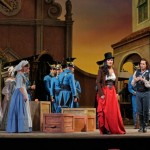by Sedgwick Clark
NOTE: BEGINNING THIS WEEK, I’LL BE POSTING MY BLOG ON THURSDAYS AT NOON RATHER THAN WEDNESDAYS.
Amsterdam’s Royal Concertgebouw Orchestra and its current music director, Mariss Jansons, stopped by Carnegie Hall last week (2/13 and 14) for a pair of concerts to celebrate the ensemble’s 125th anniversary. They were a great success, as always, with everyone on my aisle burbling over its glorious sound and virtuosity.
No doubt whatsoever, it is a great orchestra, and for many of my over-40 years of hearing it in concert it was my favorite European orchestra. But the dark, burnished sonority of yore, cultivated to such full-toned splendor during Bernard Haitink’s tenure (1963-1988), was eviscerated by Riccardo Chailly’s superficial musicianship (1988-2004). And the turnover of orchestral musicians that occurred internationally in the last two decades of the 20th century brought forth a new generation of players who pride clarity over rich, bass-oriented textures. The only orchestra I know that has managed to retain its early-1970s persona resides in Philadelphia, and it remains to be seen what effect its new music director, Yannick Nézet-Séguin, will have.
So what effect has Jansons had on the RCO? While one can’t deny his expertise on the podium, I don’t find much personality in his conducting—of the Austro-German repertoire anyway. He was at his best in the first concert, in his accompaniment to Leonidas Kavakos’s kaleidoscopic brilliance in Bartók’s Violin Concerto No. 2. Still, it was little more than an expert rendering of the score. Listen to soloist Zoltán Székely and the Concertgebouw in the live world premiere recording under Willem Mengelberg in 1939 for those little nudges of temperament I missed with Jansons or the 1958 Stern/Bernstein/New York Philharmonic studio recording (in its judiciously remixed Prince Charles Edition reissue) for no-holds-barred emotional drama.
Recalling Jansons’ devastating Mahler Sixth Symphony a few years ago on LSO LIVE, I looked forward to the Mahler First, which followed intermission. But despite the orchestra’s powerful, pinpoint playing, the Wayfarer themes didn’t sing, the third movement’s Parodie sections were poker-faced, and in general the slow music was impatient and tempo changes were exaggerated. A disappointment.
Little need be said about the next evening’s Strauss Death and Transfiguration and Bruckner Seventh. Over the weekend I pulled out my recordings of Strauss’s own 1926 Staatskapelle Berlin recording, the 1942 Philadelphia and 1952 NBC Toscaninis, 1960 Monteux/San Francisco, and 1983 Haitink/Concertgebouw of the former, and the 1951Furtwängler and 1974 Karajan, both with Berlin, of the latter. All were different, all sublime in their individual ways. Jansons sped up where Strauss marks Sehr breit (“Very broad”) for the transfiguration theme and sailed through the Wagner tuba threnody after the Bruckner’s second-movement climax. Inexplicable.
David Hamilton (1935-2013)
Another of my heroes is gone. David Hamilton, 78, died at home on February 19 after a long illness. He reviewed records and wrote occasional features for High Fidelity when I began building my record collection in college, and I relied on his insights into 20th-century music, especially that of Stravinsky. His initials at the end of a review meant “must read,” even if I had never heard of the composer.
David was a Princeton grad (A.B., 1956; M.F.A., music history, 1960), where he was the music and recording librarian, 1961-65. He was assistant music editor and then music editor at W.W. Norton, 1965-74, then became music critic of the Nation in 1968 and wrote for many publications during his lifetime. I had the pleasure of editing (if that’s the word, for his copy was immaculate) articles of his at Keynote and Musical America. His Metropolitan Opera Encyclopedia (1987) is one of my most frequently used reference books. For many years, he was producer of historical Met Opera broadcasts and wrote notes for the company’s program booklet.
One of the benefits of working in the classical division of Philips and Mercury Records in the early 1970s was that I got to know many writers who were formative in my musical taste. It’s easy to remember my first lunch with David: We were each going to hear Boulez conduct the Philharmonic that evening in what turned out to be one of the great Mahler Sixths I ever heard, and with a grin he pulled out the Mahler Critical Edition score from his briefcase.
We often saw each other at Boulez concerts. The conductor’s Rug Concerts were nearly always sold out, and long lines of the converted would form to get the best seats on the floor. I always arrived early and when the doors opened would storm up the escalator as the ushers shouted, “No running allowed.” (Shades of elementary school!) When David was there, I would save him room. But one night, an all-Schoenberg Rug Concert was only about half full. I remarked after a striking performance of Pierrot Lunaire that it was too bad it hadn’t sold out. “Well, look at it this way,” he replied. “Have you ever seen so many people at a Schoenberg concert?”
David succumbed to Alzheimer’s disease, one of those ironies that we who remain find so baffling in those of such extraordinary intellects. His long-time friend Sheila Porter was with him the afternoon before he died and told me that she and his nurse chose James Levine’s Met recording of Mozart’s Marriage of Figaro for him to hear.
